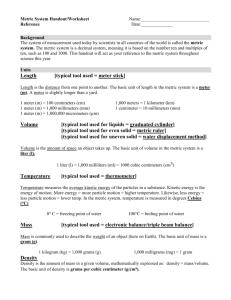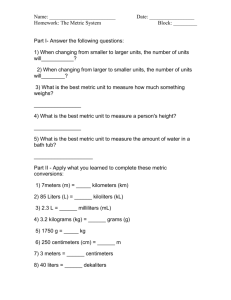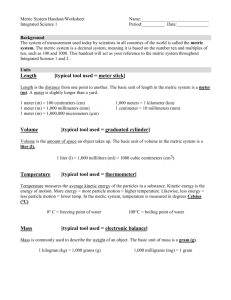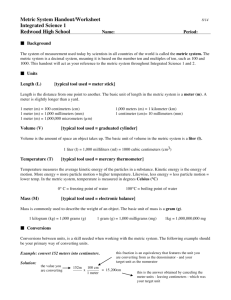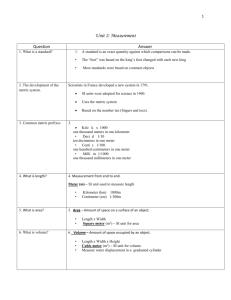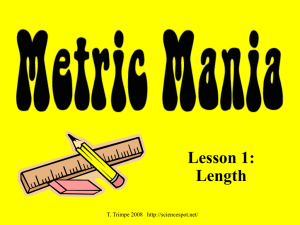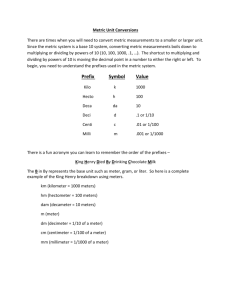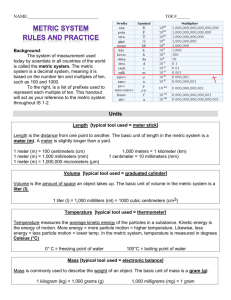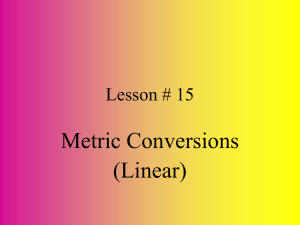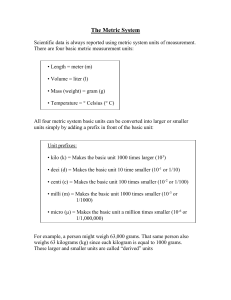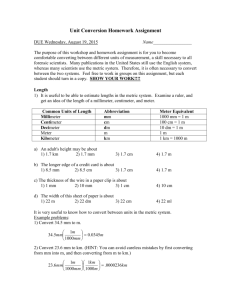File - Science with Ms. Washington
advertisement
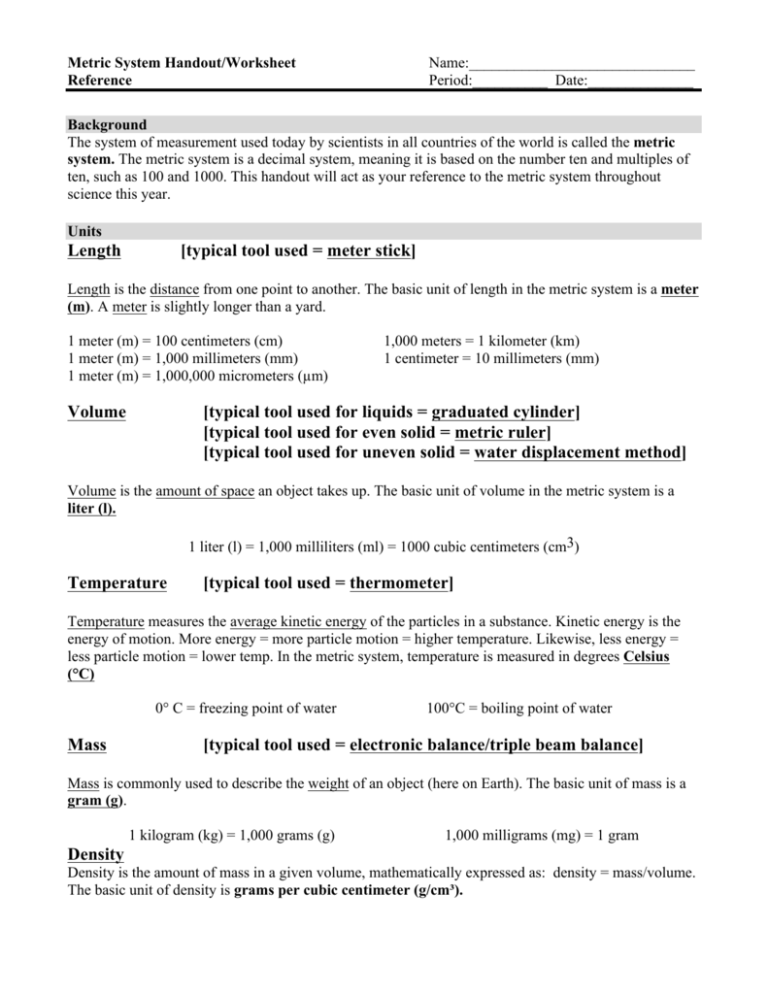
Metric System Handout/Worksheet Reference Name:______________________________ Period:__________ Date:______________ Background The system of measurement used today by scientists in all countries of the world is called the metric system. The metric system is a decimal system, meaning it is based on the number ten and multiples of ten, such as 100 and 1000. This handout will act as your reference to the metric system throughout science this year. Units Length [typical tool used = meter stick] Length is the distance from one point to another. The basic unit of length in the metric system is a meter (m). A meter is slightly longer than a yard. 1 meter (m) = 100 centimeters (cm) 1 meter (m) = 1,000 millimeters (mm) 1 meter (m) = 1,000,000 micrometers (µm) Volume 1,000 meters = 1 kilometer (km) 1 centimeter = 10 millimeters (mm) [typical tool used for liquids = graduated cylinder] [typical tool used for even solid = metric ruler] [typical tool used for uneven solid = water displacement method] Volume is the amount of space an object takes up. The basic unit of volume in the metric system is a liter (l). 1 liter (l) = 1,000 milliliters (ml) = 1000 cubic centimeters (cm3) Temperature [typical tool used = thermometer] Temperature measures the average kinetic energy of the particles in a substance. Kinetic energy is the energy of motion. More energy = more particle motion = higher temperature. Likewise, less energy = less particle motion = lower temp. In the metric system, temperature is measured in degrees Celsius (°C) 0° C = freezing point of water Mass 100°C = boiling point of water [typical tool used = electronic balance/triple beam balance] Mass is commonly used to describe the weight of an object (here on Earth). The basic unit of mass is a gram (g). 1 kilogram (kg) = 1,000 grams (g) 1,000 milligrams (mg) = 1 gram Density Density is the amount of mass in a given volume, mathematically expressed as: density = mass/volume. The basic unit of density is grams per cubic centimeter (g/cm³). kilo 1000 hecto the value you 100 are converting deci Unit milli centi this fraction is an equivalency that features the unit you 0.1 meter are converting 0.001 0.01by -canceling the denominator and your the this isfrom the as answer obtained liter target unit meter as theunits numerator - leaving centimeters - which was gram your target unit 1 Conversions-Metric to Metric Conversion between the different units within the metric system is accomplished by using the ‘Quick Conversion Line’ to move the decimal point the appropriate number of places in the appropriate direction. deka 10 How can you remember this? Kids Having Doughnuts Usually Drink Chocolate Milk In-class examples: 58.9 kg = g 9,852,614 mm = km 852,614 mL = L .007621 kL = L Another method for conversion utilizes a mathematical formula: Example: convert 152 meters in centimeters. Solution: 152m x 100 cm = 15, 200cm 1 meter € Practice Unit Conversions Complete the following problems (in the space provided) by showing all of your work - and by drawing a box around your final answer. 1. 3 meters into centimeters 2. 10 kilometers into meters 2 Metric System Practice Fill in the chart below based on the reference sheet above. Measurement Metric Basic Unit Length meter (m) Measuring Device/Tool meter stick Volume of a liquid a) b) Volume of an even solid c) d) e) liters (l) water displacement cup/method Temperature f) g) Mass h) i) j) grams/cubic centimeter (g/cm³) k) Practice Unit Conversions Complete the following problems (in the space provided) by showing all of your work - and by drawing a box around your final answer. 4. 15,050 milligrams into grams 5. 3,264 milliliters into liters 5. 9,674,444 grams into kilograms 6. 3.1 kilograms into milligrams 7. 5,897,159 milligrams into kilograms 3 An equivalency that features the unit you are converting from as the denominator and your target unit as the numerator What you are converting Conversions-Metric to English The answer obtained by canceling the meter units - leaving yards - which was your target unit Example: convert 152 meters to yards. 152m x 1.094 yards = 166.288 yards 1 meter Solution: Practice Unit Conversions Complete the following by showing all of your work - and by drawing a box around your final answer. “Showing all of your work” means setting up the entire equation and using unit abbreviations for each value 1. 4.5 inches into centimeters 2. 25.3 meters into feet 3. 2.3 miles into kilometers 4. 14 inches into centimeters 5. 125 pounds into kilograms 4
